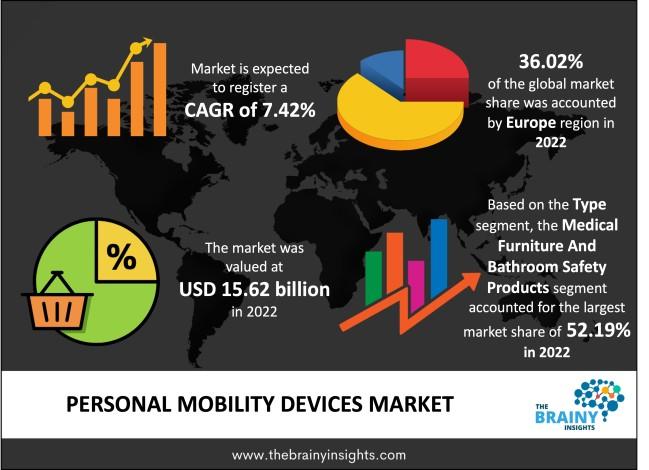
Market Overview
The global personal mobility devices market has witnessed steady growth in recent years, driven by the rising aging population, increasing prevalence of disabilities, and growing awareness of assistive technologies. These devices, which include wheelchairs, mobility scooters, canes, crutches, and walkers, enhance the quality of life for individuals with mobility impairments. Technological advancements, coupled with favorable reimbursement policies in developed countries, are further supporting market expansion.
The global personal mobility devices market was valued at USD 15.62 billion in 2022 and is expected to grow at a compound annual growth rate (CAGR) of 7.42% from 2023 to 2032, reaching USD 31.95 billion by 2032.
Market Dynamics
Drivers
- Aging Population: Increasing geriatric population globally is leading to a higher incidence of mobility-related issues.
- Rising Disabilities: Prevalence of chronic diseases and physical impairments is propelling demand.
- Technological Advancements: Innovations like powered wheelchairs, smart mobility aids, and lightweight materials are boosting adoption.
- Healthcare Investments: Expanding healthcare infrastructure and supportive government policies aid market growth.
Restraints
- High Cost of Advanced Devices: Limited affordability in emerging economies may hinder adoption.
- Lack of Awareness: In rural and underdeveloped areas, awareness regarding personal mobility devices remains low.
Opportunities
- Emerging Markets: Growing healthcare access and income levels in Asia-Pacific and Latin America present lucrative opportunities.
- Integration of IoT & AI: Smart mobility solutions offer enhanced safety and autonomy for users.
Regional Analysis
North America
- Leading market due to high healthcare expenditure, aging population, and technological innovation.
- U.S. dominates the region with robust reimbursement frameworks.
Europe
- Strong growth supported by aging demographics, particularly in Germany, France, and the UK.
- Government programs aid adoption of assistive technologies.
Asia-Pacific
- Fastest-growing region, driven by increasing investments in healthcare, large population base, and rising awareness.
- China, Japan, and India are key contributors.
Latin America & Middle East & Africa
- Moderate growth expected due to economic challenges and lower healthcare spending.
- Gradual improvements in infrastructure and awareness may boost demand.
Segmental Analysis
By Product Type
- Wheelchairs (Manual & Powered)
- Mobility Scooters
- Canes & Crutches
- Walkers
- Others (Stair Lifts, Rollators)
By End-User
- Hospitals
- Homecare Settings
- Rehabilitation Centers
- Others
By Technology
- Manual Devices
- Powered Devices
- Smart Mobility Devices
Request PDF Brochure: https://www.thebrainyinsights.com/enquiry/sample-request/13680
List of Key Players
- Invacare Corporation
- Sunrise Medical LLC
- Permobil AB
- Pride Mobility Products Corp.
- Drive DeVilbiss Healthcare
- Ottobock SE & Co. KGaA
- GF Health Products, Inc.
- Karma Medical Products Co., Ltd.
- Hoveround Corporation
- Medline Industries, LP
Key Trends
- Rising use of IoT and AI for remote monitoring and smart navigation.
- Growth of customizable and ergonomic designs.
- Increasing rental and refurbished market for affordability.
- Collaborations and M&A for product innovation and market expansion.
Conclusion
The personal mobility devices market is poised for significant growth, underpinned by demographic shifts, medical advancements, and evolving consumer expectations. With continuous innovation and expanding access in emerging markets, the industry offers considerable opportunities for stakeholders across the value chain.
For Further Information:
